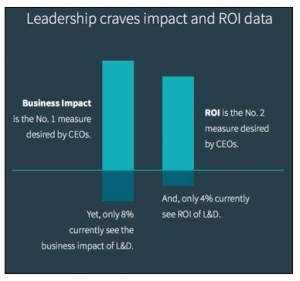If you throw a lot of training at a problem, you might be getting some results but they may not be the exact results you need. Too much training with too few results is a sign that your corporate learning might be top-heavy with learning programs built to solve ill-defined problems that don’t focus on clear business solutions.
You can tighten up your flabby programs when you clearly identify your knowledge gaps and define the exact behaviors that will close them. Then make sure those gaps align with your strategic plans.
In fact, LinkedIn Learning’s 2018 Workplace Learning Report found that executives want learning leaders to more closely align training programs with business objectives. Business leaders are overwhelmingly asking for learning to reflect business imperatives and make an impact on the business.
All of this begs the question: What is the best way to design your corporate knowledge management efforts to align with your business objectives?
The answer to this question is evolving because the technology to create a robust internal corporate knowledge management is improving all the time. While the tech exists now, you still need to have a clear vision of the knowledge you need to capture to get you where you are going.
Just to get started, here are a few overarching ideas to consider as you create your knowledge management plan.
- Be clear about where you are today and where you want to be tomorrow. And yes, tomorrow means your 1-year, 3-year, 5-year and beyond strategic plans. These plans get fuzzier the farther out you go because a lot is changing on the ground but it is good to have some general ideas about where you would like to be.
- Figure out who your experts are that know how your business runs and thrives today. Some of them will be retiring and some of them will be the bright bulbs you just hired. Identify the things you need to know and the people who know it.
- Finally, begin to consider the best ways to capture the knowledge you need to know to secure your current position/customers/contracts/business and what you need to capture or acquire to meet your long-term strategic goals.
Yes, that’s a lot to think about. So over the next few months, we’ll start to dig into each of these areas in more detail. Stay tuned.



Please note: I reserve the right to delete comments that are offensive or off-topic.